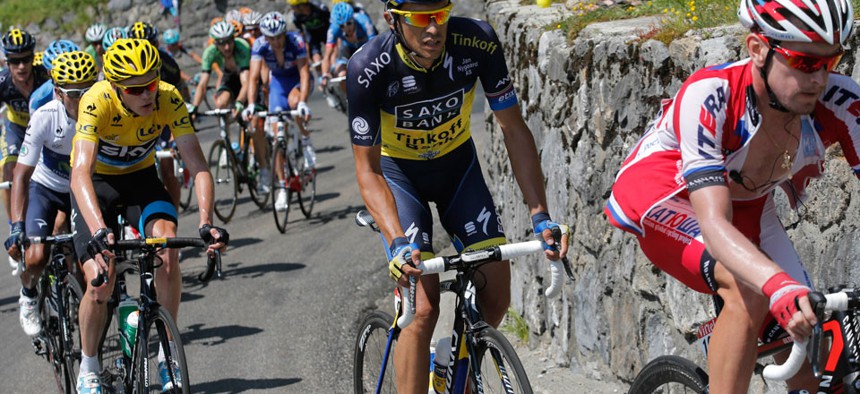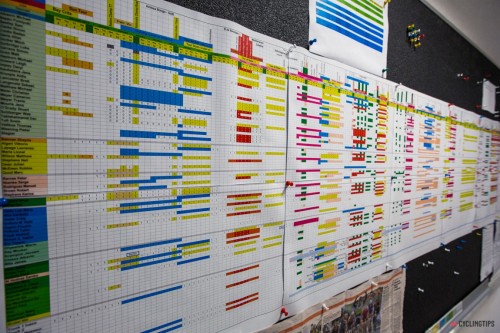
Cyclists compete in the 2013 Tour de France in July. Christophe Ena/AP
How to Run an Effective Staff Like a Tour de France Team
Australia's Orica GreenEdge team has an effective way to manage strategy and operations.
The best time of summer is about to start in 4 days: the 100th edition of the Tour de France (TdF)! Time for an operations view behind the screens of the first and only Australian world-tour team: Orica GreenEdge. As a starter, here’s just a beautiful example of visual project management:
Before getting into team management, consider team strategy:
Those unacquainted with the sport may wonder why one would need a team in cycling: isn’t it just riding your bike? There are two key reasons to have 9 riders work for the same goal in road racing:
1) the physics of pushing bike and body into the wind are such that the second rider, tucked behind the wheel of the first rider, saves easily 30 to 40% of power while riding at the same speed. Hence, the team has a hierarchy: the “domestiques” are paid to ride their heart out in the wind, sacrificing their own chances to win to shelter their team general-classification (GC) leader and deposit him (reasonably) fresh near the bottom of the final climb or the team sprinter less than 1km from the finish. No Yellow Jersey could have won the TdF without their team.
2) the team may have different, and sometimes, multiple goals: some teams, like the British team Sky, may have the singular goal of having their team leader (Chris Froome) win the Tour; i.e., complete the 3 weeks in the cumulative shortest time = winning the general classification. Froome is surrounded by 8 (super-)domestiques to help him through the flat and the mountain stages. Other teams, like the Belgian OmegaPharma-QuickStep, may go only for stage wins with their sprinter Mark Cavendish. And then there are teams, like the Belgian Lotto-Belisol, that pursue two goals: go for some stage wins on the flats or the rolling hill stages with their sprinter Andre Greipel or a classics rider, and go for the overall win or podium with their GC rider Jurgen Van Den Broeck. That means that the team domestiques will be divided in their tasks. All else being equal, strategy is easier to execute with a singular goal.
What are the back office processes to execute this strategy? The operations management behind a world-tour team which is about complexity management of custom needs: These top teams often compete in two to three races simultaneously, almost always in different countries and sometimes on different continents. Teams have about 25 to 35 riders, each coming from different parts of the world, going to different races at different times, endowed with their own physique and particular strengths. They have customized bikes (different bikes for different disciplines like a time trial, a one-day classics race on the cobbles in Flanders, or a mountain stage), uniforms (“kits”), and food preferences. In addition to the riders, there is a set of capital equipment (buses, trucks, cars, all with their contents) and staff (30+ people) to be planned and coordinated.
Given that all top-level cycling races (including the three “grand tours” of France, Spain, and Italy, and the 5 one-day classic races–the “monuments” of Milan – San Remo ( Italy ), Tour of Flanders ( Belgium ), Paris–Roubaix ( France ), Liège–Bastogne–Liège (Belgium), Giro di Lombardia (Italy)) are still is the old world, world tour teams have their “base camp” (“service course”) somewhere in Europe, comprised of administrative offices and a warehouse. The Aussies chose Northern Italy:
The manager of the service course, Jacopo Scampin, told us that Varese isn’t the nicest place in Italy (but we thought it was pretty beautiful), but from a logisitcs point of view it works very well with the Milan Airport (Malpensa) being only 20 mintues away and the Swiss and French borders being close by.
For some interesting eye candy, take a look at
A TOUR OF THE ORICA-GREENEDGE SERVICE COURSE
.







